Much of the text on this page is adapted from the California Division of Mines publication “The Mother Lode Country” Bulletin 141 published 1948.
The California Gold Rush was the most significant event in the history of the settlement of the western frontier. The initial discovery was made in January 1848, but news traveled slowly and although many miners arrived in 1848, the beginning of the Gold Rush was the following year in 1849.
In 1848 news of the discovery reached the East Coast by ship, south all the way around the tip of South America, a journey that could take six months or more. The news traveled down the coast to Mexico and South America, and over the Pacific Ocean to China, much faster than it reached America’s population centers. South Americans and Chinese were the first to arrive in 1848, at a time when California’s non-native population was primarily Mexican.
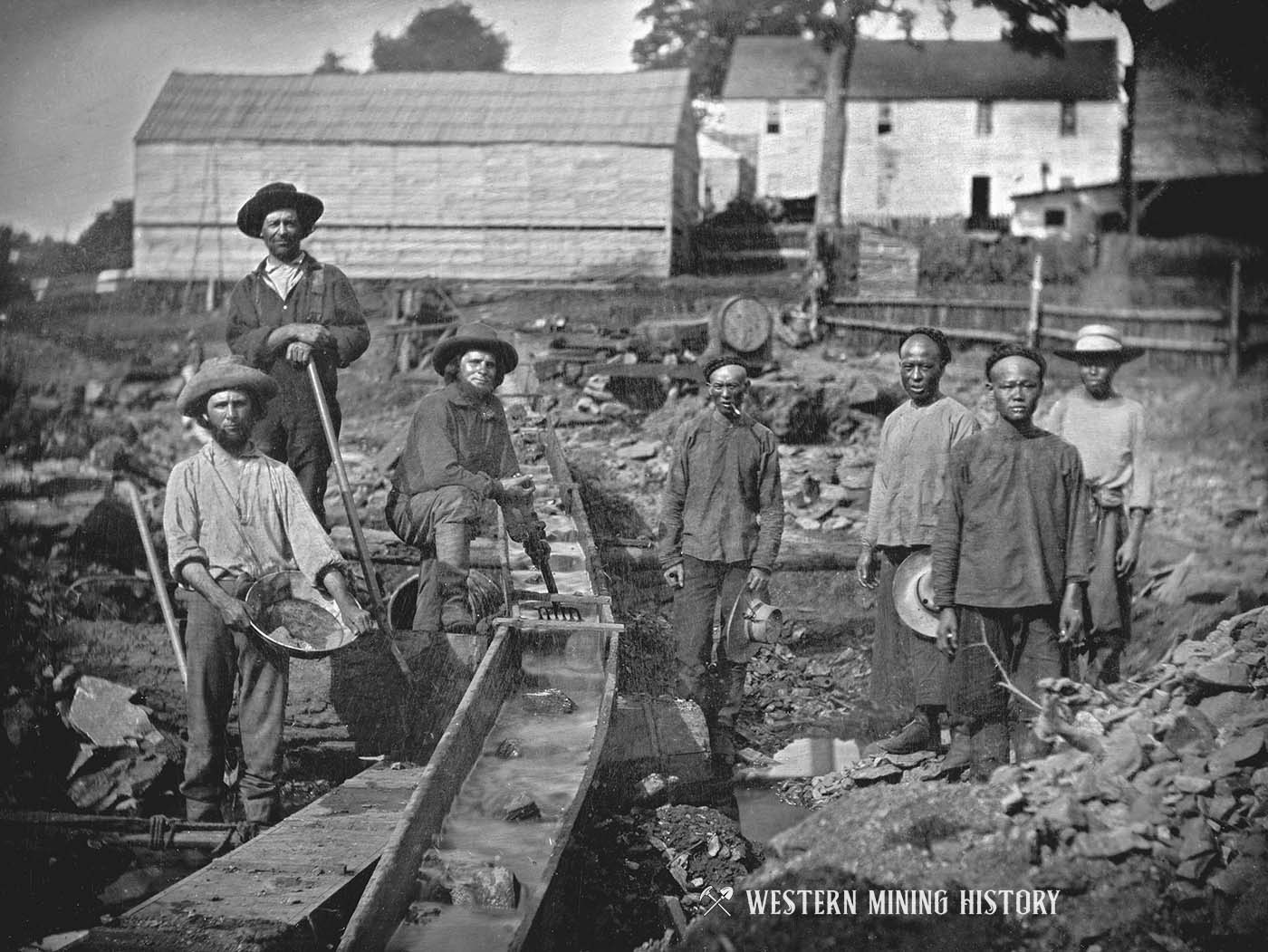
When news of the gold discovery arrived in the East, people were initially skeptical. California might as well have been the other side of the world at that time, and few were willing to risk everything to chase rumors. However, that all changed on December 5, 1848, as US President James K. Polk confirmed the discovery of gold in an address to Congress. Men by the thousands began preparations for the trek to California, and by the Spring of 1849, the great Gold Rush was on.
The rush to the California gold fields transformed both California and the nation. Between 1849 and 1855, and estimated 300,000 people from around the globe arrived in California. The population grew so quickly that in September 1850, California became a state without going through the usual territorial status.
“the discovery which electrified the world, altered the course of western history, greatly accelerated the development of California, and had national and international ramifications”
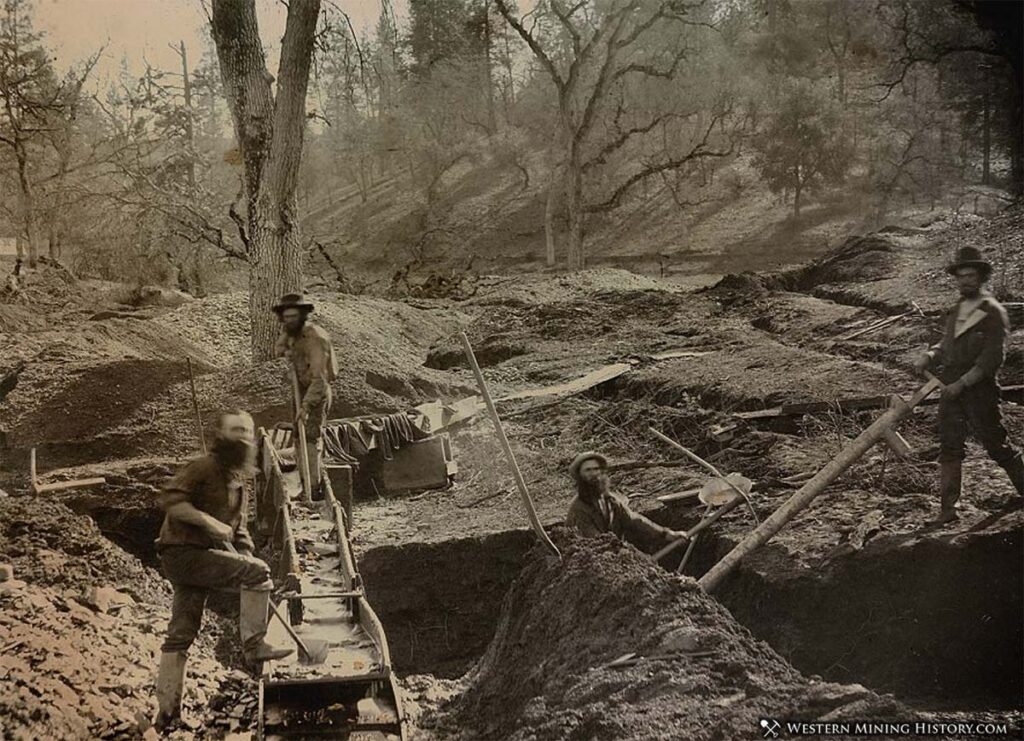
Discovery of Gold at Sutter’s Mill
James Marshall was not the first to find gold in California, nevertheless it was this New Jersey carpenter, in the employ of John Sutter, who made the effective discovery which electrified the world, altered the course of western history, greatly accelerated the development of California, and had national and international ramifications.
For years, John Sutter, grantee and almost feudal baron of a large Mexican grant in the vicinity of present day Sacramento, desired to provide a supply of lumber for his own use and for sale. Consequently he provided for the establishment of two mills, a sawmill at Coloma and a gristmill at Natoma. The latter mill was to use the products of the former in its construction.
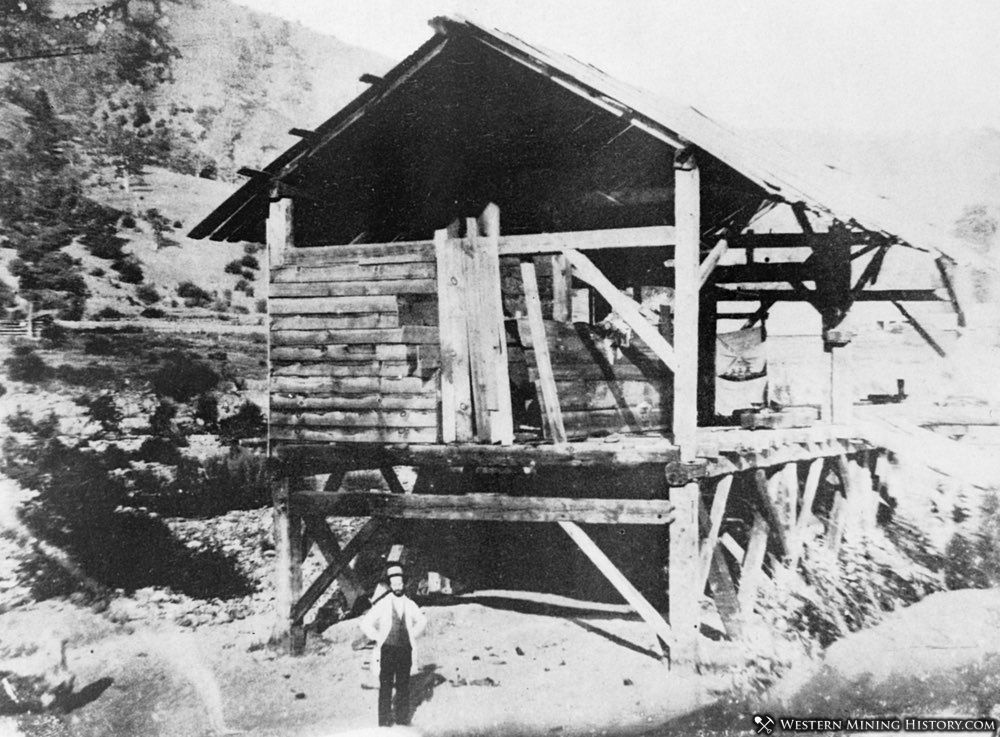
In August 1847, Sutter signed a contract with Marshall which provided that Marshall should erect and operate the mill and that Sutter should supply the labor, tools, supplies and equipment. After they had determined the location for the proposed mill on the South Fork of the American River, in a small valley which was later to be called Coloma, they built two cabins, one to house the workers and the other the boss—Marshall.
The work of construction of the mill advanced quite rapidly after its commencement in September. Laborers, Indians, Mormons and others were employed and the work on the mill was almost finished by January of the following year (1848). This early completion was due in considerable measure to the industry and abilities of the Mormon workers who had been recently discharged from the Mormon Battalion.
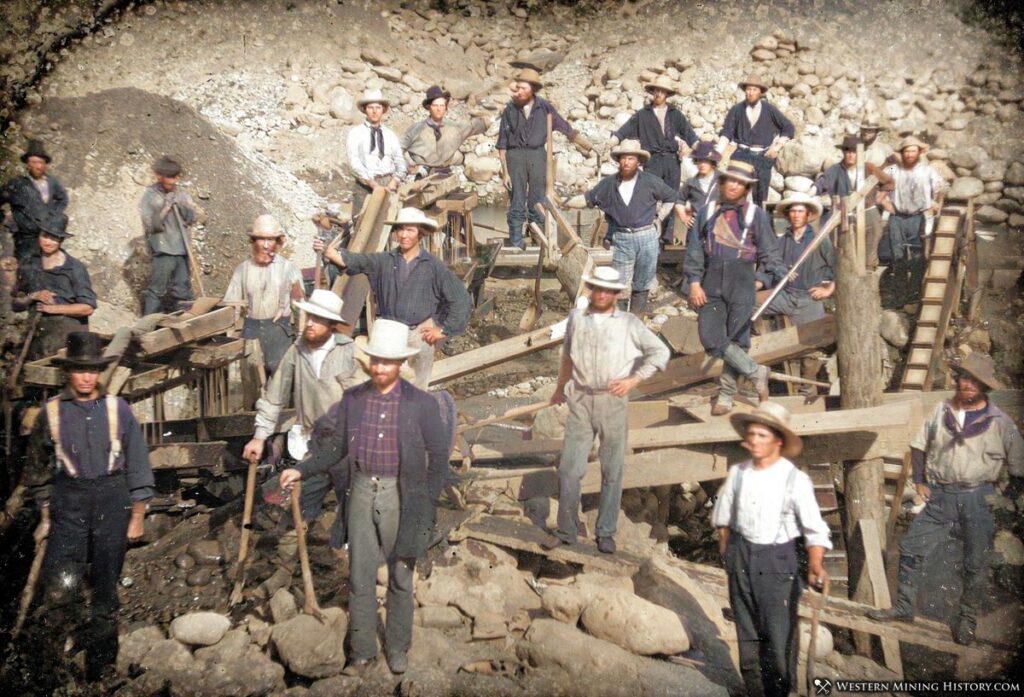
The story of this group of soldiers and their part in the discovery of gold in California is of considerable interest. The battalion, about 500 strong, volunteered for service in the United States Army for the Mexican War. Besides desiring to aid their country, the Saints enlisted in order to become the advance guard of the Mormon westward migration. The termination of their one year enlistments found a considerable portion of the original group in Southern California, after having opened a wagon road to the West.
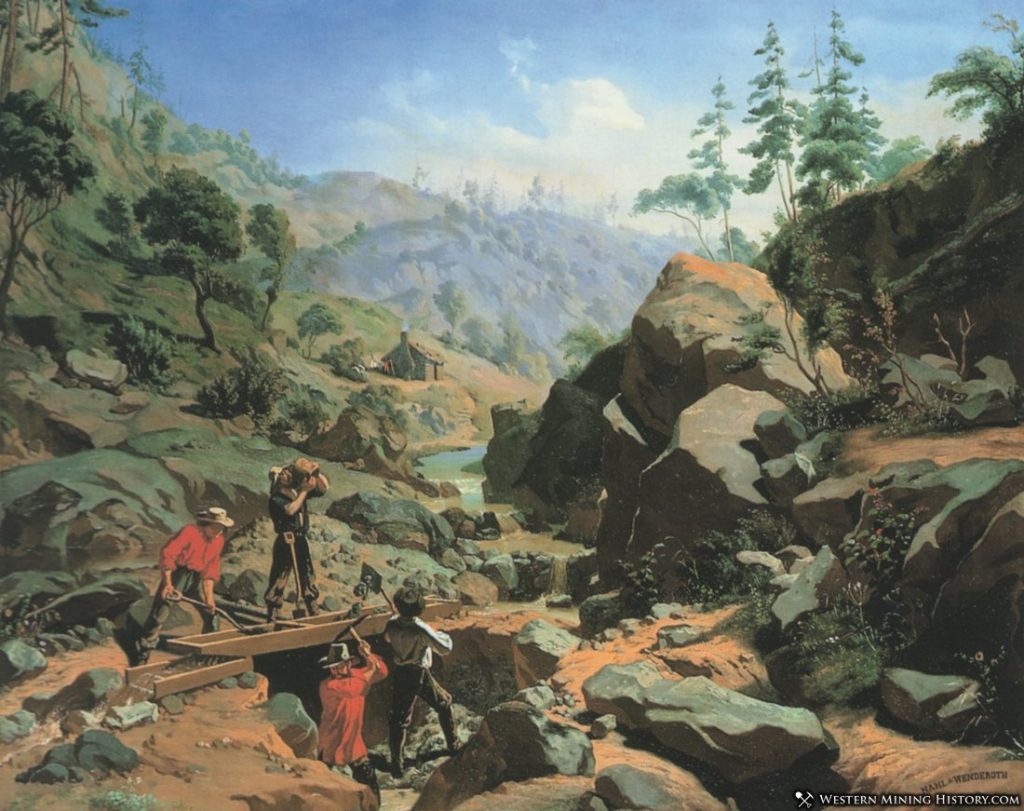
Some of the group, about 81 in number, re-enlisted for an additional year of service. The remainder, some 240, were released after exemplary service. By this time the Battalion had been informed that the new headquarters for the faith was to be in Utah, and they began to head for that destination.
The soldiers were not, however, the only Mormons in the Golden State at the time, for on July 31, 1846, a group of homeseekers had arrived aboard the sailing ship Brooklyn led by Sam Brannan as presiding elder. Late in 1847, this same Brannan met the homeward bound group of ex-soldiers at Tahoe Basin. There he urged the men to remain in California until the following spring since it was already September.
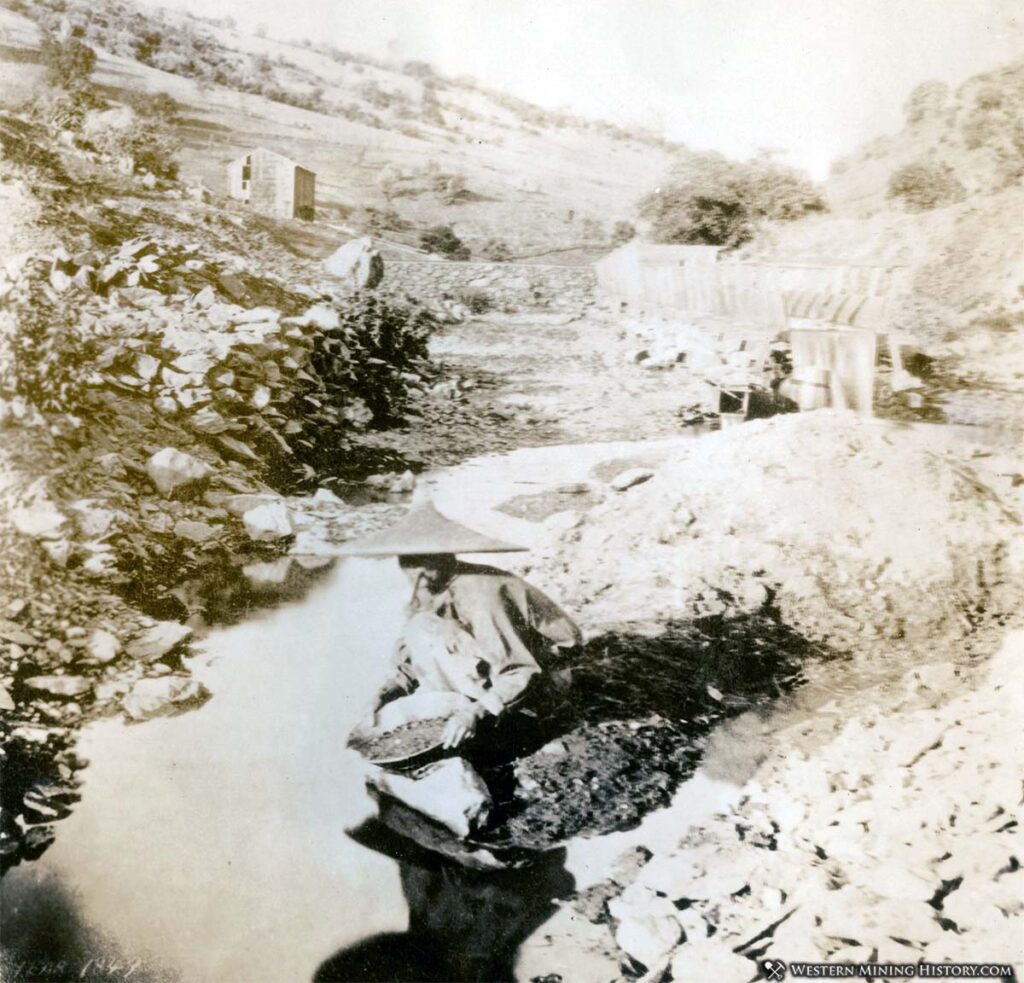
Brannan’s entreaties were of no avail but a bundle of letters and an epistle from Brigham Young, which arrived the following day, changed the minds of many. In the epistle they were advised by their leader to remain in California until they had outfitted themselves, unless their presence in Utah was essential. Thereupon most of the group turned back and sought employment in California.
About 40 of the young ex-soldiers found work with John Sutter, some being sent to Natoma, some to Coloma, and others remaining to work at Sutter’s Fort at New Helvetia. Probably about nine of the Mormons were assigned to Marshall at Coloma, this group entering into a contract with Sutter whereby they agreed to remain in his employ until the completion of work on the sawmill.
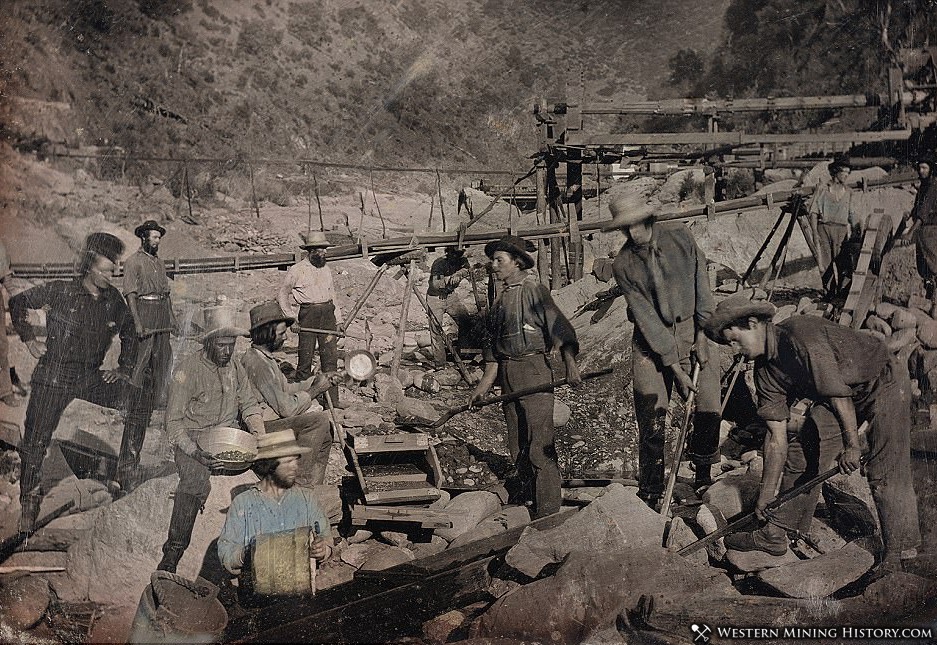
One of the Mormons, Henry Bigler, kept a diary from which historians have drawn heavily in determining the details of the discovery and the actual date thereof as January 24, 1848. In spite of the discovery of gold the Mormons completed the provisions of their contract with Sutter and engaged in mining only when they were off duty at the mill.
By March 11th, the work on the sawmill was finished and it was in operation. Presently the Mormons terminated their contract with Sutter, were paid off at about $1.50 per day for work at the mill, and set about digging gold on a full time basis at Mormon Island near the confluence of the South and Main Forks of the American River.
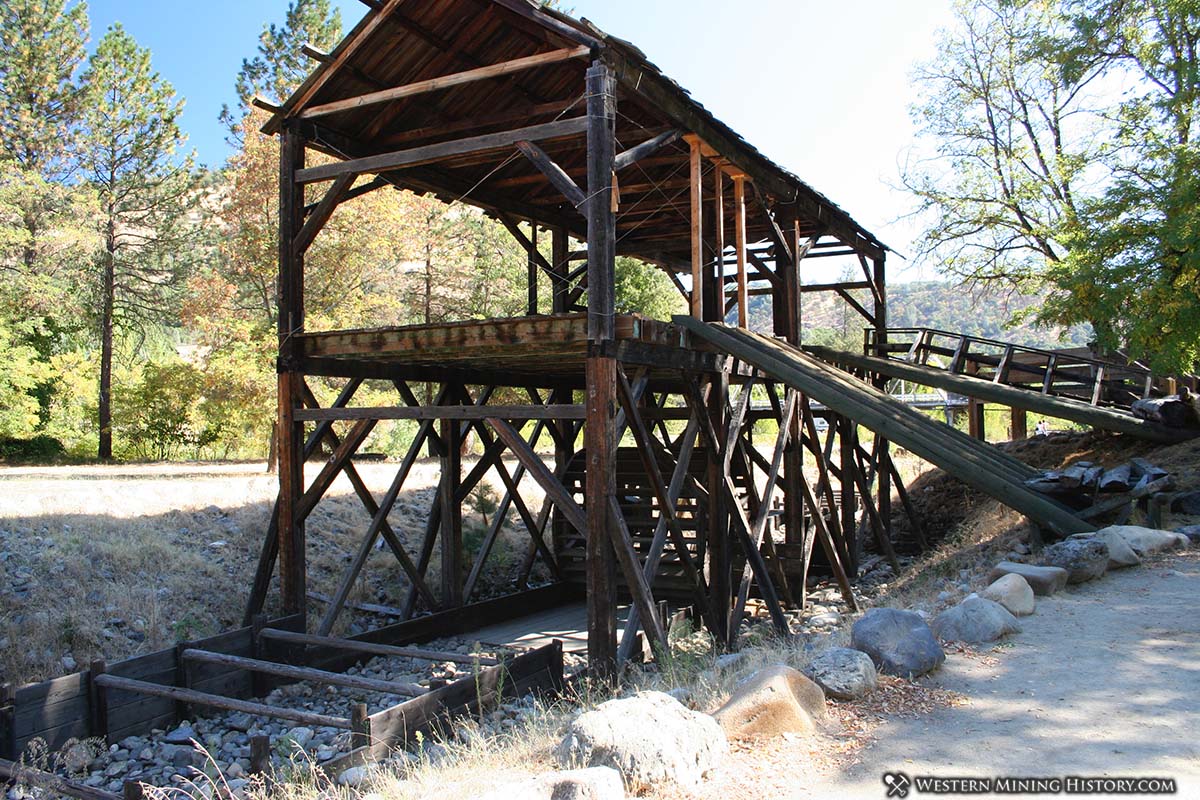
Here many of the Saints joined in the enterprise, working the area until June of the same year, at which time the members of the Battalion decided to leave for the home in Utah which they had not yet seen. In July, forty-five of them united and left the easy money of California for the alkaline plains of Salt Lake Valley, because of their attachment to the faith. This marked the first return of miners from the gold fields, and was a preview of the role that California would play in the filling in of the West.
Just as the date of the discovery has been a subject of discussion, the accounts of the events leading up to Marshall’s find and his actions thereafter conflict in different narratives. The main facts however are in accord.
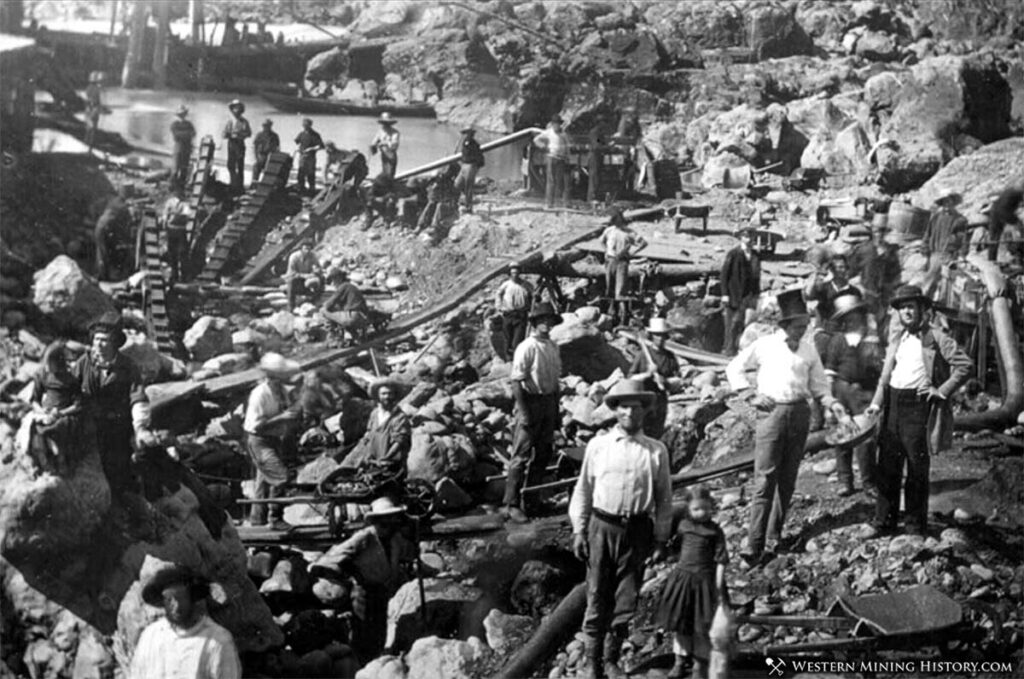
The sawmill constructed by Marshall was operated by diverting the water of the river through a headrace into the forebay of the mill, whence it was directed to the waterwheel, flowed under the length of the mill and escaped back into the river through a tailrace. It was determined by test in December 1847, that the mill foundations had been set too low and therefore the water did not escape sufficiently into the tailrace. This necessitated the deepening and widening of the race to expedite the run-off of the water.
Leaving the mill in the same month, Marshall ordered that this work should be accomplished in his absence. Upon his return to the mill, Marshall found that his orders had been carried out, but the race was still not sufficiently deep. Additional excavation was done during the daytime, and at night the gates of the forebay were opened and the running water assisted the work by clearing away the loose dirt. Boulders were blasted out and the decomposed granite was being dug out manually by both the Indian laborers and the Mormons.
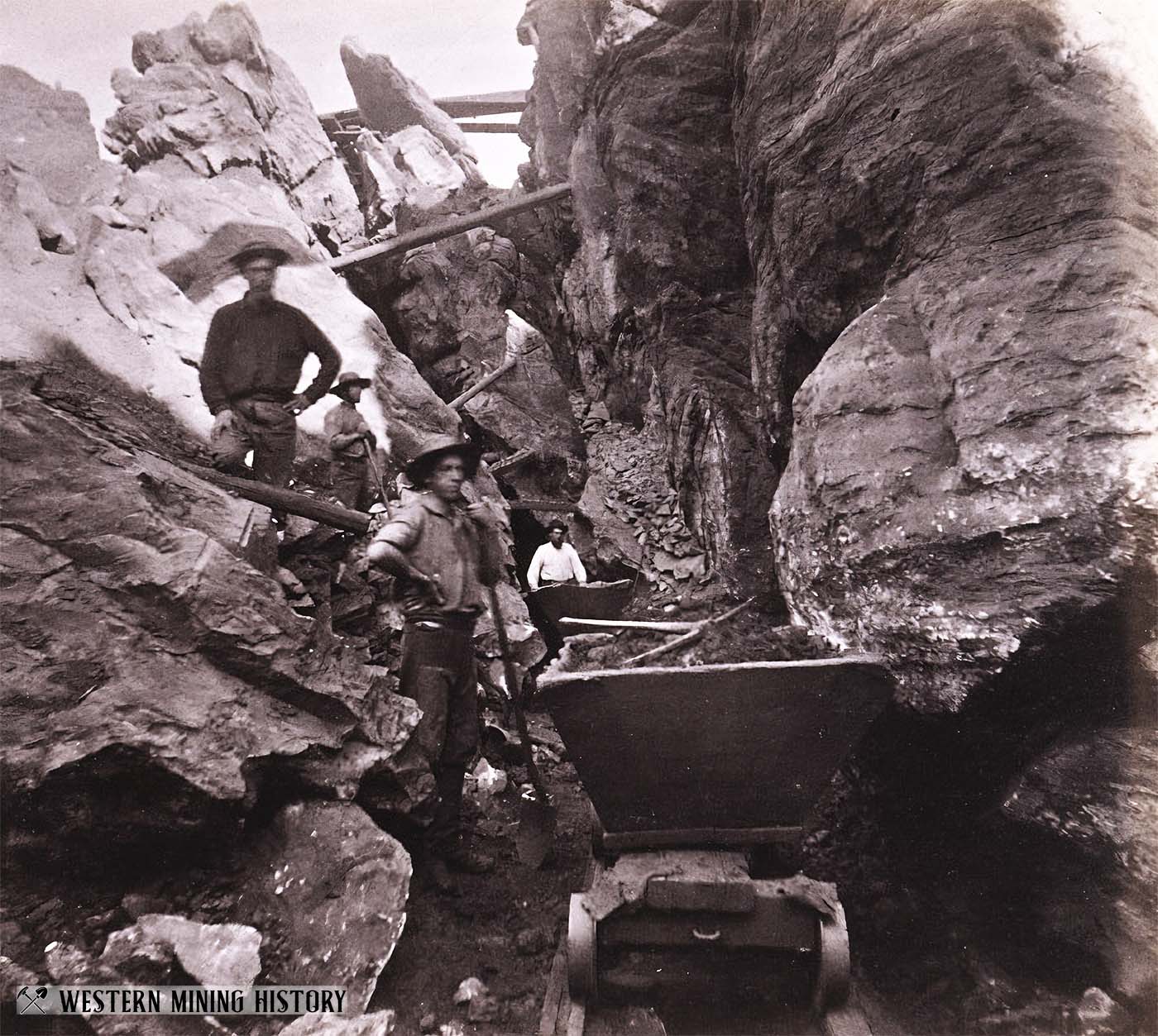
On the morning of January 24th, when Marshall was making one of his frequent inspections of the tailrace, something glittering caught his eye. There, resting in a shallow depth of water, was a yellow flake of what appeared to be metal. Testing its malleability, he became hopeful; he picked up some more flakes, placed them in the crown of his hat and made his way to where the men were working.
The Mormons shared Marshall’s interest and several elementary tests were made, by which the group could not disprove the possibility that the metal was gold. Work on the mill was halted temporarily while all went to the tailrace to pick up these available flakes of metal.
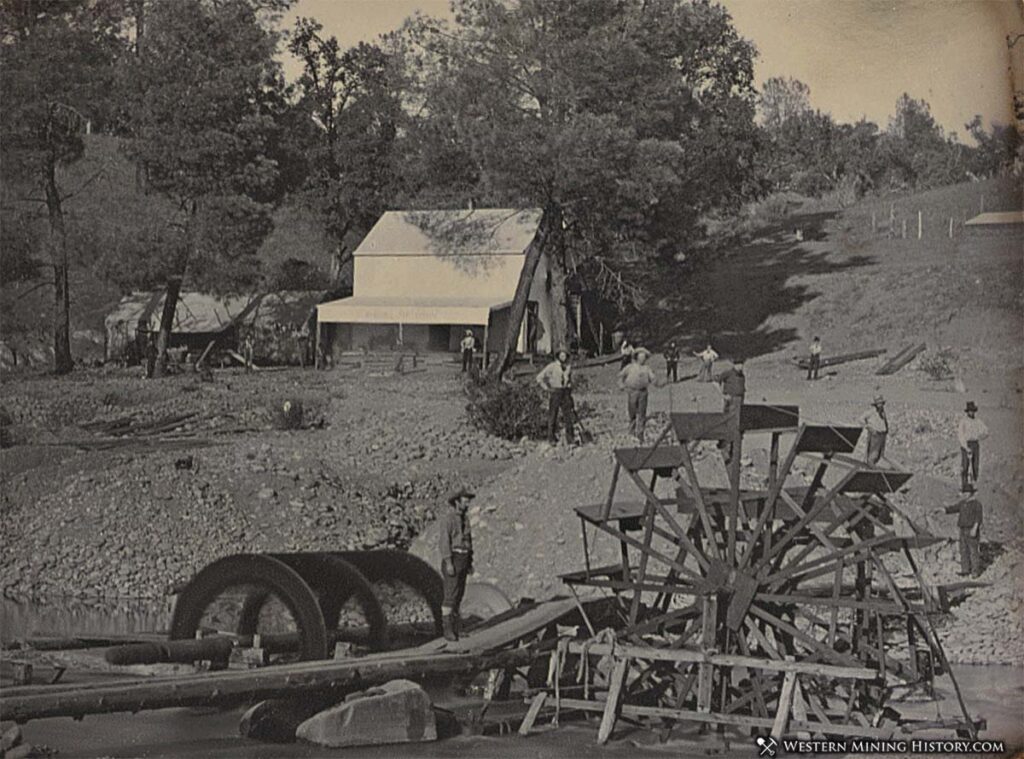
The plans of Sutter and Marshall to keep the discovery quiet came to naught, for the secret of gold could not be kept. The ex-soldiers at the Coloma millsite confided the secret to their associates at Natoma. Charles Bennett, sent by Sutter to Monterey to secure a grant of the Coloma area from Governor Mason, could not restrain himself from showing the gold in Benicia and San Francisco. Upon hearing of gold, Sam Brannan, the Mormon elder, could not curb his curiosity and visited Sacramento. Upon his return to San Francisco he did not hesitate to proclaim the discovery.
Even Sutter, who most wanted the secret maintained, confided the news to General Vallejo. The first published announcement of the discovery of gold was made on March 15, 1848, in the San Francisco weekly newspaper The Californian, and no longer could the discovery be withheld from the whole world.
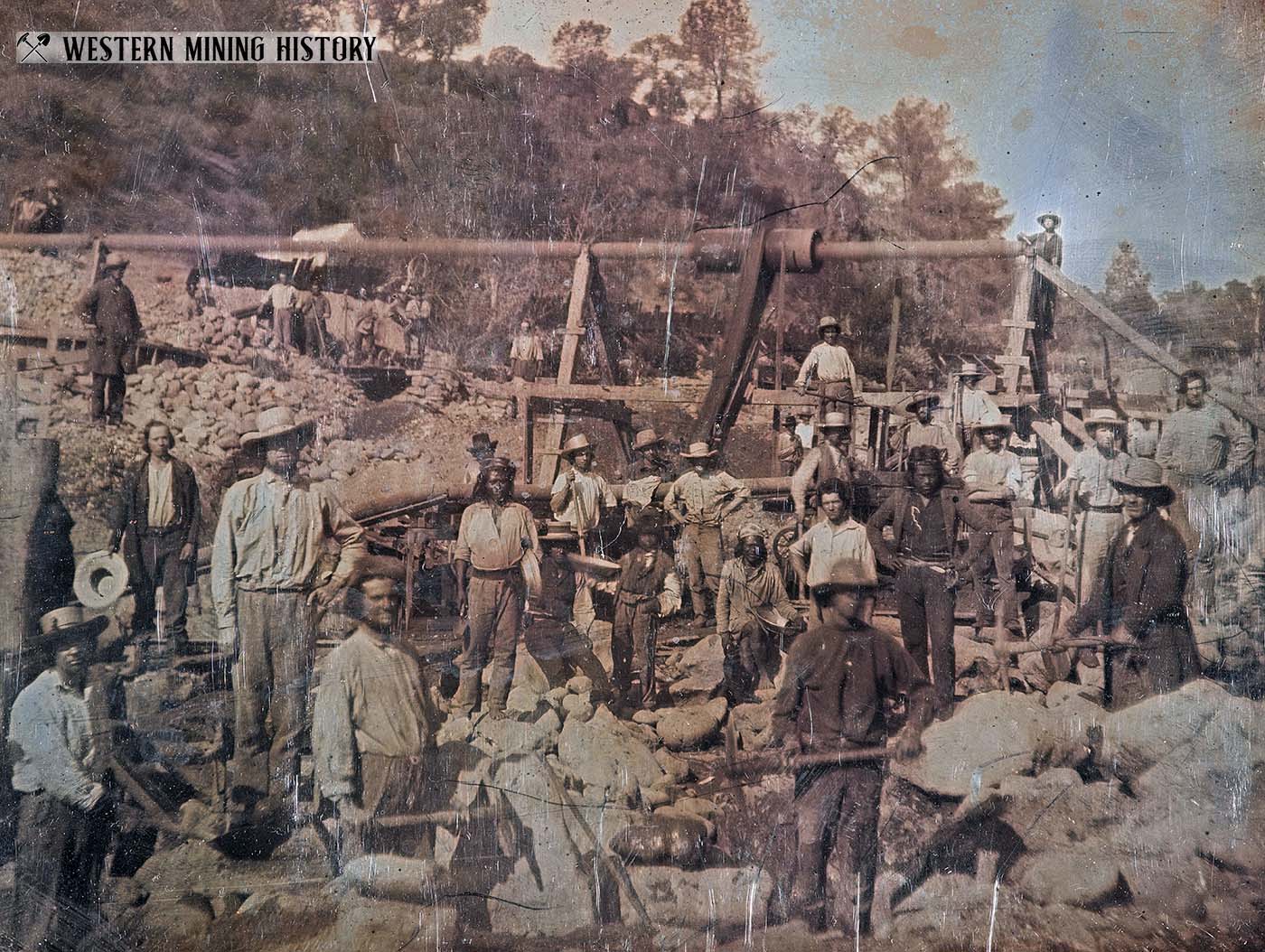
Gold Fever at San Francisco
As word got out about the discovery at Sutter’s Mill, there was a frenzied rush among current residents of Pacific settlements to the newly discovered gold fields. A September newspaper article described the situation in San Francisco: “Three-fourths of the houses in San Francisco are actually vacated; even lawyers have closed their books, and taken passage, with a spade and wooden dish, to make fortunes by washing out gold from the sands on the Sacramento.”
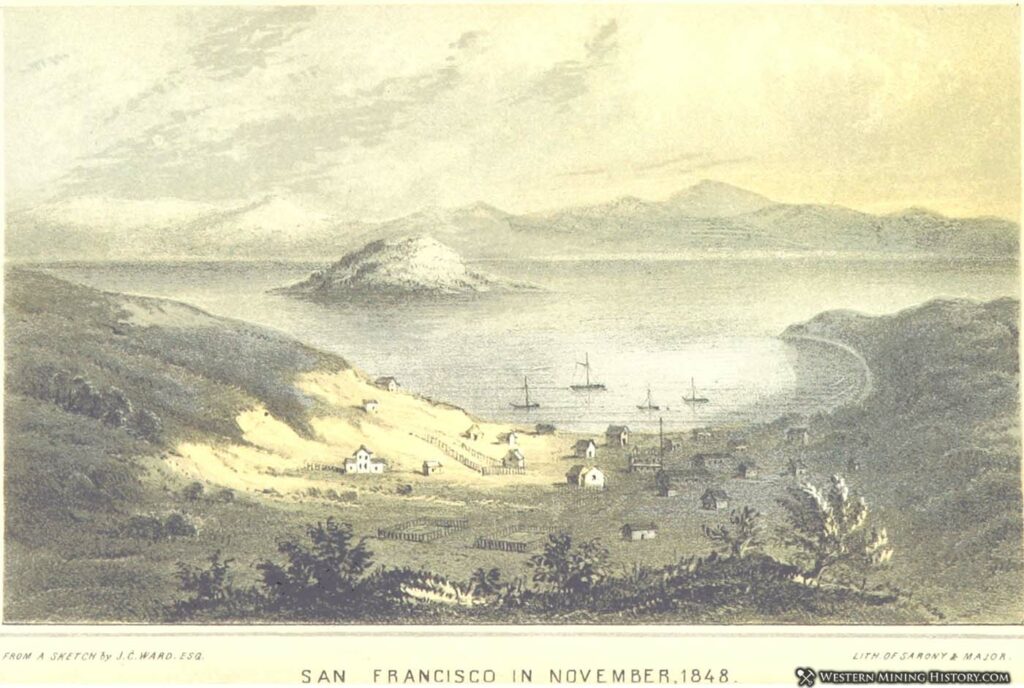
“Cooks and stewards have refused fifty dollars a month to remain under their former employers. Clerks’ wages have risen to a thousand a year. Carpenters, blacksmiths, and teamsters, who in April received three dollars a day, now refuse ten; a few still remain, making shovels, spades, and pick-axes, and turning wooden bowls, who are making upwards of twenty dollars a day.”
“I am informed that one blacksmith makes ten to fifteen small picks, and sells them as a favor at $6 each. English spades and shovels will command $10 each, and by taking them to the gold regions, yield a heavy profit by selling again. There is not in town one new shovel for sale, perhaps not a tin cup or pan. A boat requires four days to go from here to Sutter’s Fort. The fare has risen from $4 to $12, each passenger carrying his own provisions. Wooden bowls, worth in New York 10 to 15 cents, would sell here now for $5.”
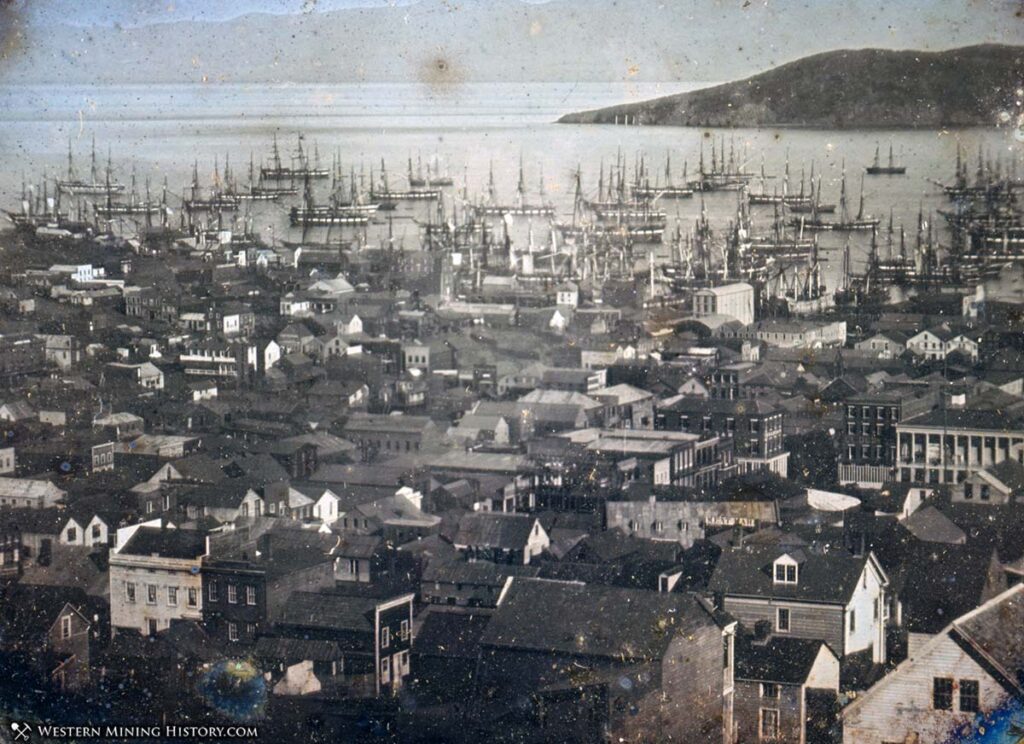
The article goes on to explain the situation of a local newspaper that was forced to cease publication due to the fact that there were few open businesses to pay for advertising, and few citizens left to read the newspaper as nearly everyone had left for the placer mines.
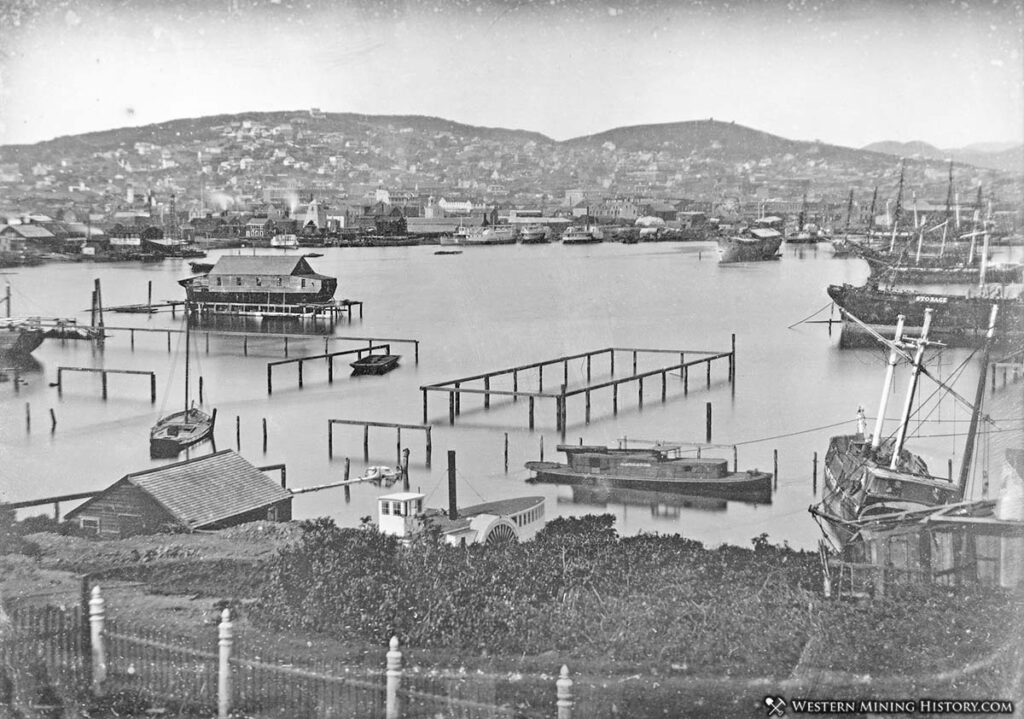
Ships were arriving at San Francisco in large numbers and many of the crews were abandoning them to set out for the gold fields. Even if captains had a crew, there was not enough cargo or passengers leaving to justify the cost of the return trip.
These ships choked the harbor, and many of them were sunk or burned to make room for new arrivals. Others were deliberately ran aground so owners could assert “salvage rights” and claim valuable real estate. These ships were then used as storage, or sometimes even commercial buildings like hotels or saloons.
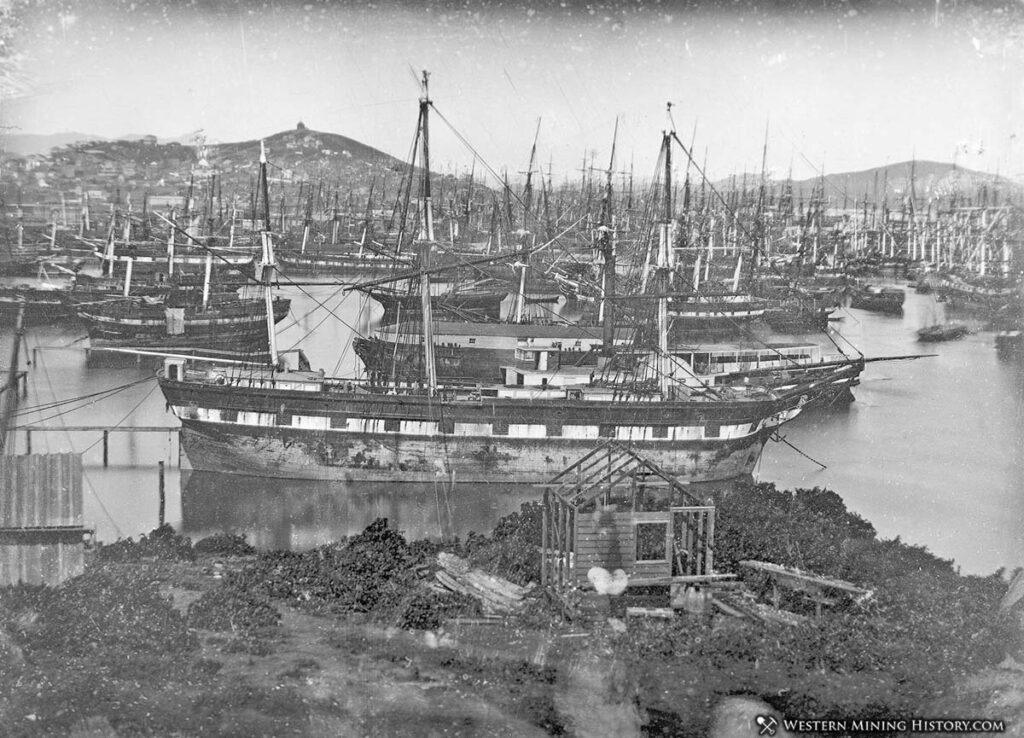
The legacy of the abandoned Gold Rush ships is an ongoing part of San Francisco’s history as the ships are sometimes unearthed as part of new construction projects. It is estimated that around 40 ships are buried beneath the Embarcadero and the Financial District, which was once the original shoreline.
San Francisco was an empty shell by the fall of 1848, but in 1849 when the global rush to California began, it became the most important port city on the Pacific coast. In 1847 an estimated 400 people lived in the settlement, the next year that number was 25,000, and by 1852 a staggering 150,000 people inhabited the city.
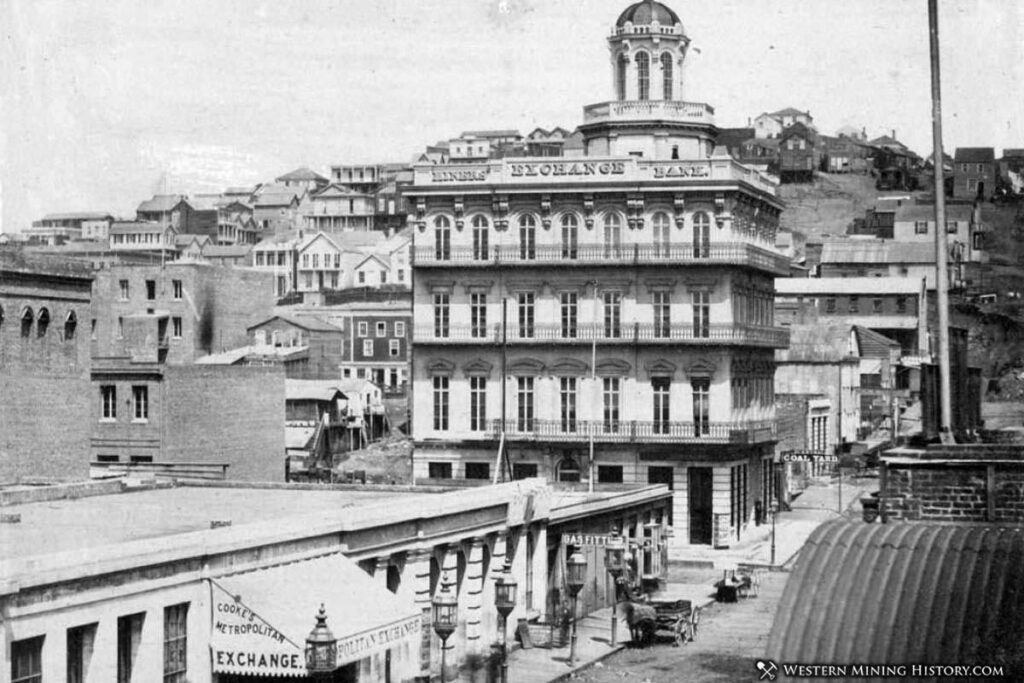
As a result of the Gold Rush, San Francisco went from a small village to one of the nation’s most important cities in less than a decade.
Expansion of the California Gold Fields
The easily worked alluvial deposits of gold extracted by the early miners made mining look simple, and this fact added to the many stories of fabulous wealth lured thousands of men to the gold fields of California. Nevertheless the discovery of new placers did not await their coming. Not long after Marshall’s discovery, John Bidwell, grantee of Rancho Chico, visited the Coloma site. Returning home to his rancho, he found gold at what became known as Bidwell’s Bar on the Feather River.
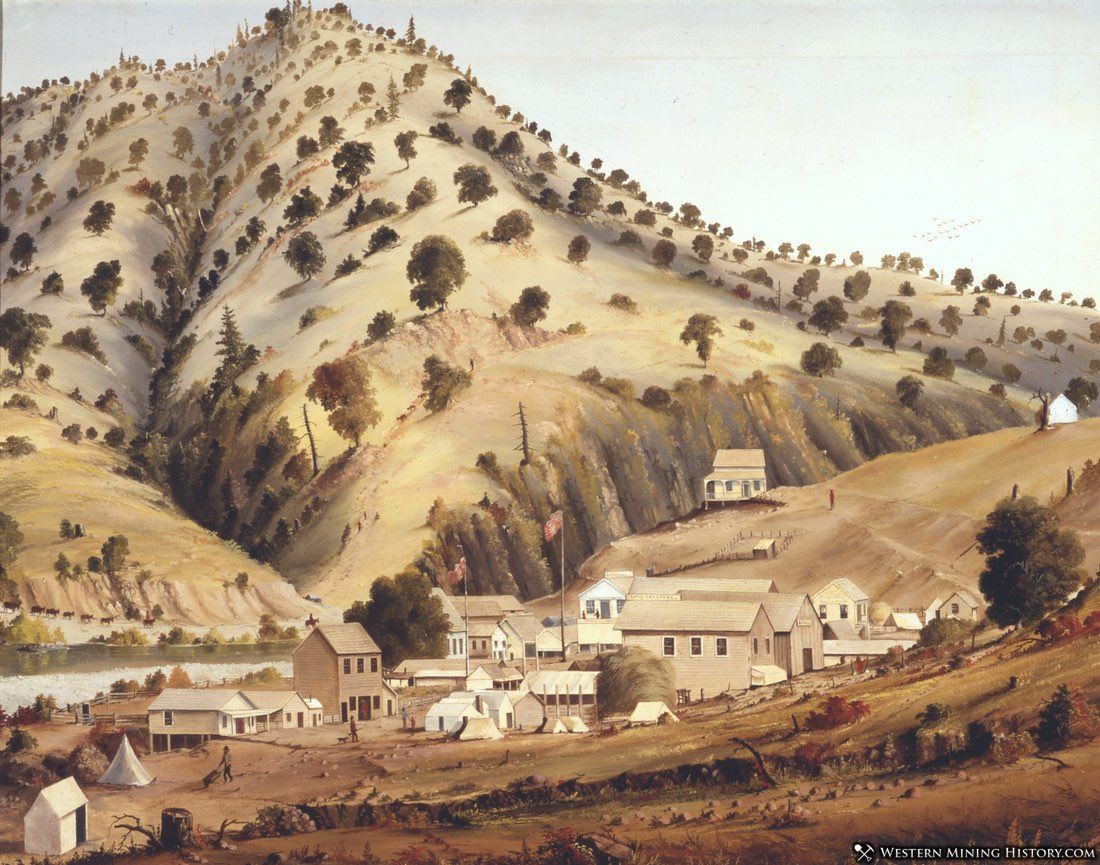
P. B. Reading also visited the discovery site, became convinced that there were similar indications on his land, and on his return to his home found some deposits on Clear Creek, which he worked with Indian labor. Success on Clear Creek led Reading to further finds on Trinity River, just as success on the Feather River stimulated discoveries on the Yuba. Before the end of 1848, finds of gold had become numerous and the gold area extended from the Tuolumne on the south to the Trinity on the north.
Men of mining experience sought the source vein or veins from which the alluvial deposits originated. The first such vein, which was of gold quartz, was discovered on Colonel John C. Frémont’s Mariposa grant in August 1849. It was probably not until 1850 or 1851, that the term Mother Lode was first applied. At that time it was used to designate a vein worked at Nashville, twelve miles south of Placerville.
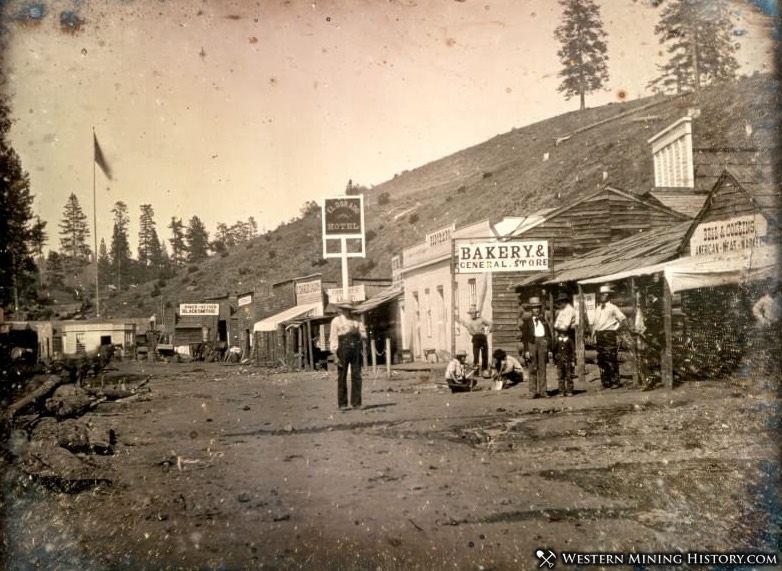
In the years following ’48 and ’49, more and more areas were opened and worked, and the gold production of California was immense. The significance of these discoveries, of the resulting rushes, and of the partial abandonment of the area is enormous. Thousands of men came by wagon, by ship and even by foot to become rich in the Golden State. Most of them desired to return home after striking it rich. Some did, but many remained in California to populate the new American acquisition.
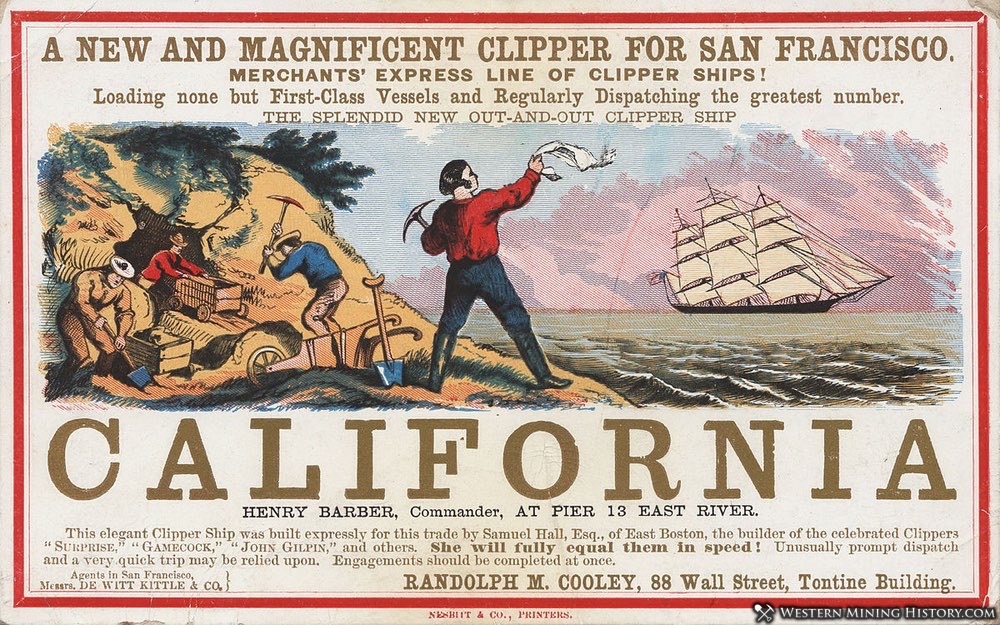
The Northern Gold Region
With tens of thousands of miners pouring into California, existing goldfields became overrun, and many were quickly mined out. New arrivals were forced to expand their search for gold deep into California’s wilderness.
In the spring of 1849, gold was discovered north of the Sierra Nevada Goldfields near what would become the town of Shasta. Shasta was so remote that it was accessed by 180 miles of trail from Sacramento. Nonetheless, many men traveled beyond Shasta, deep into the Klamath Mountains region of Northern California, one of America’s most rugged regions.
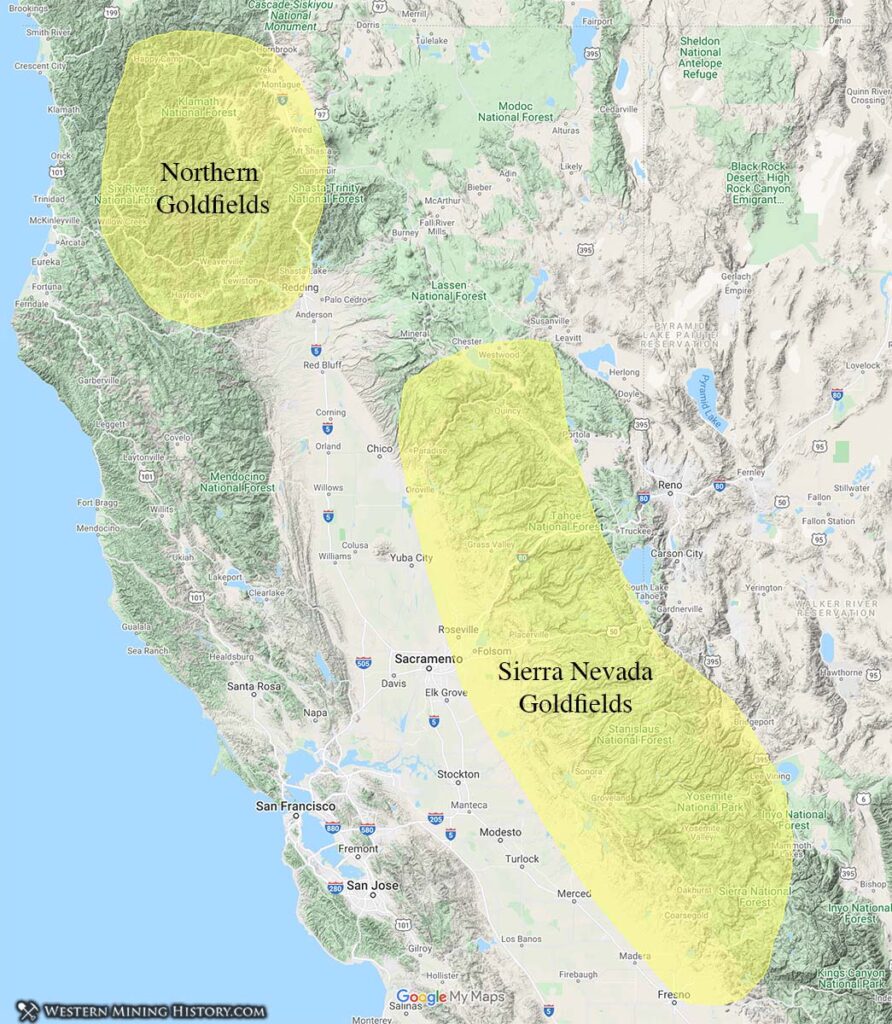
The push into the northern wilderness was a reckless and dangerous affair in 1849. Miners quickly outpaced the available food supply, and there was much suffering and starvation during the winter of 1849-50. Many were forced to return to the more established areas to the south that first year.
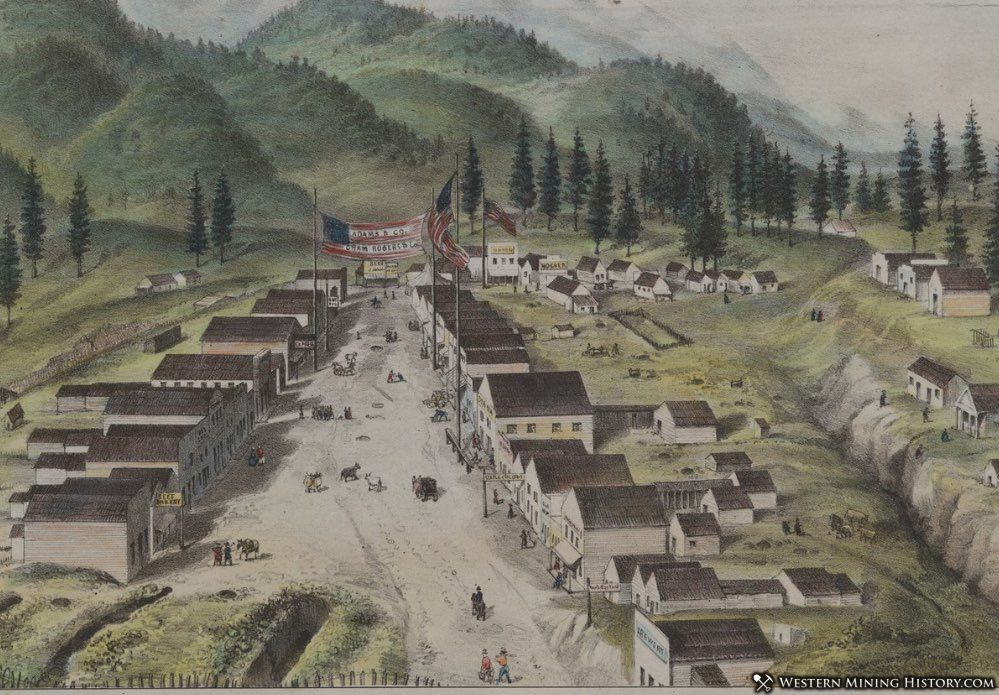
In 1850 the town of Weaverville was settled in the Trinity River area of northern California. Weaverville became the most important settlement in the northern goldfields, with thousands of people, including over 1,000 Chinese. The town was so remote that it could only be accessed by trails for nearly a decade – a road finally linked Weaverville to the outside world in 1858.
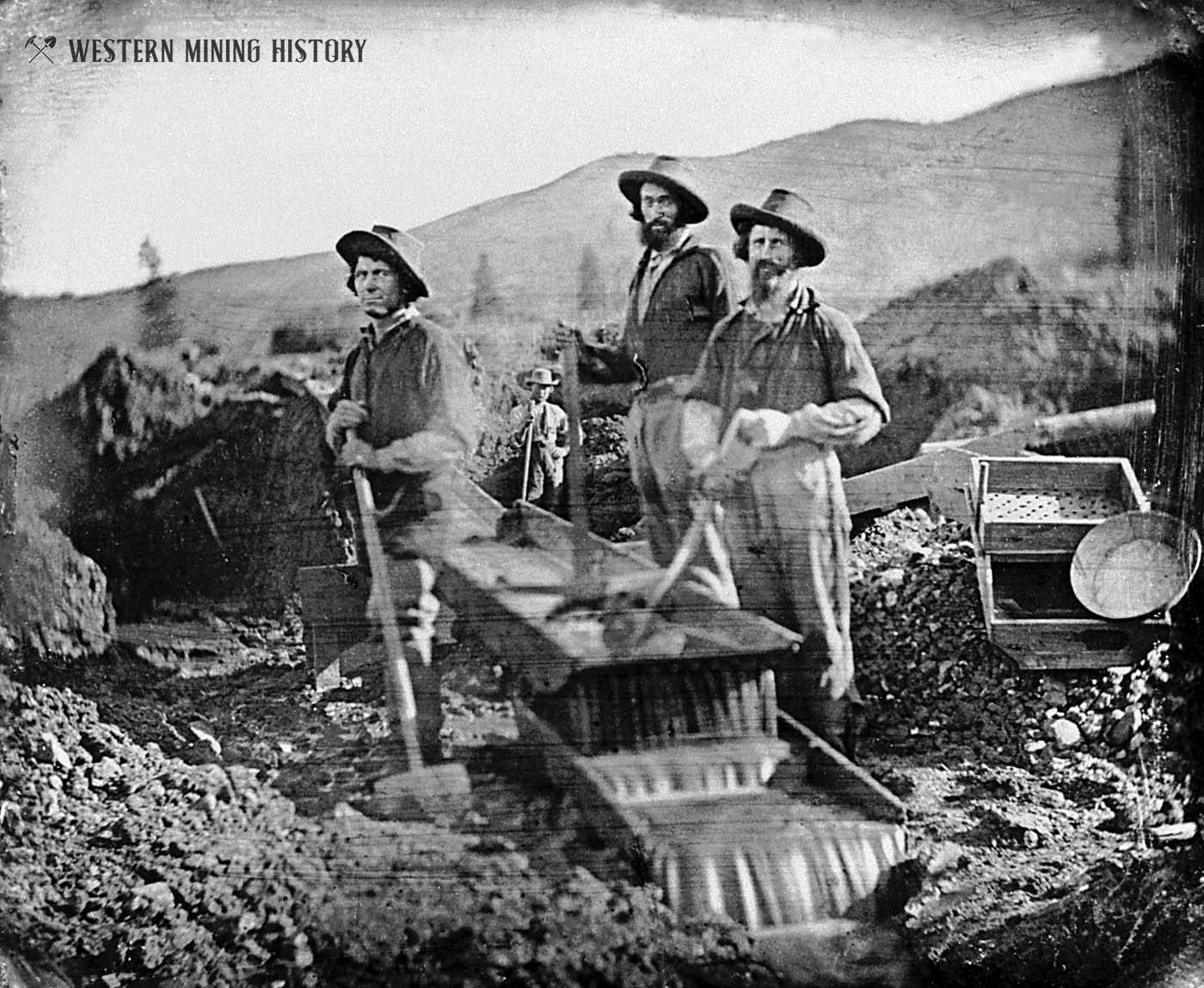
In 1851 a party of prospectors led by Abraham Thompson discovered gold at the location that would become the settlement of Yreka. Both Yreka and Weaverville were important centers of mining, commerce, and government, and both towns still serve as seats of county government.
The northern goldfields region was the state’s second most important mining area, after the Sierra Nevada region, where gold was initially discovered.
Early Advancements of Mining Techniques
While in San Francisco, Sutter’s agent, Charles Bennett, sought the advice of an ex-Georgia miner, Isaac Humphrey, and showed him the gold. The miner lost very little time in getting to the location of the discovery and became the first of many professional miners in the gold fields.
Among other things he is credited with having introduced machinery when, on March 9, 1848, two days after his arrival, he made use of the rocker for the first time in California. He had the distinction of being the first professional only by the space of a few days, for a French Canadian backwoodsman soon arrived who had had previous mining experience in Sonora. He was Jean Baptiste Ruelle, called by all simply Baptiste.
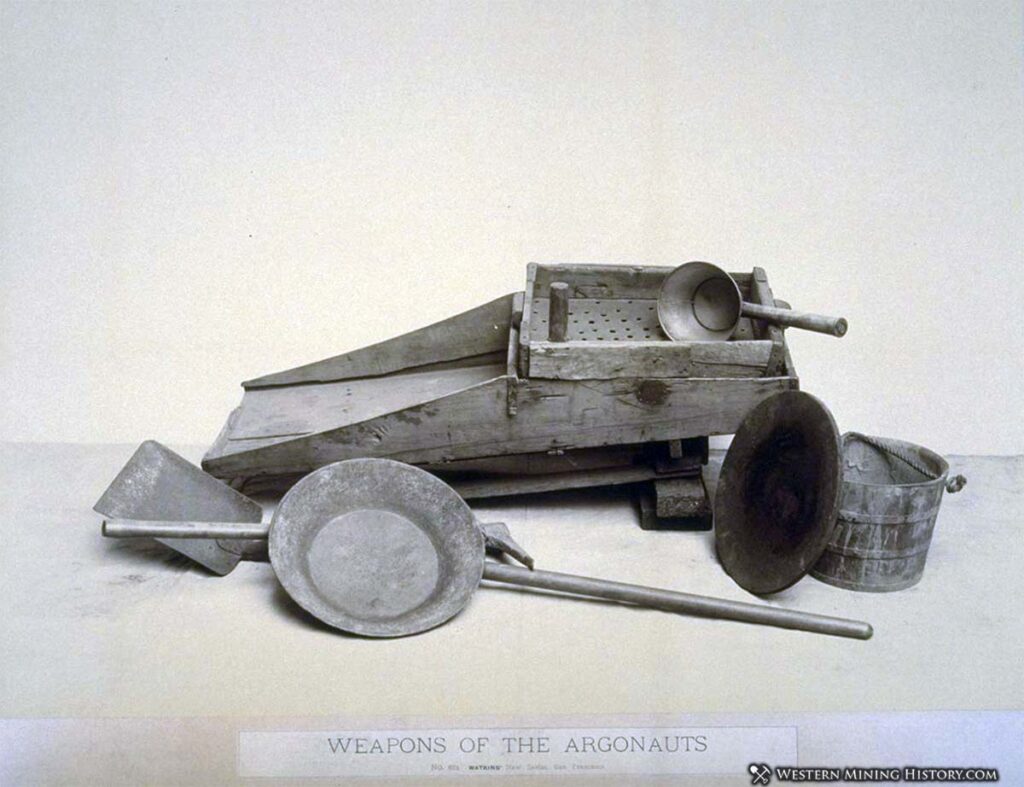
He and Humphrey were a great help to the many greenhorns, who were arriving in increasing numbers. These mining men, augmented by the arrival of some Sonorans from the Los Angeles placers, were the authorities on gold mining, the Sonoran miners being the vanguard of thousands of foreigners to be lured by California’s wealth.
The crude method of pen-knife and butcher-knife mining soon gave way to more adequate methods of placer mining. The batea, or dish shaped Indian basket, the iron gold pan, and the cradle, which were used to expedite the process of separation of gold and sediment, were soon in evidence. The cradle (or rocker as it was often called) proved to be inefficient because of the loss of many of the small particles, and was soon improved.
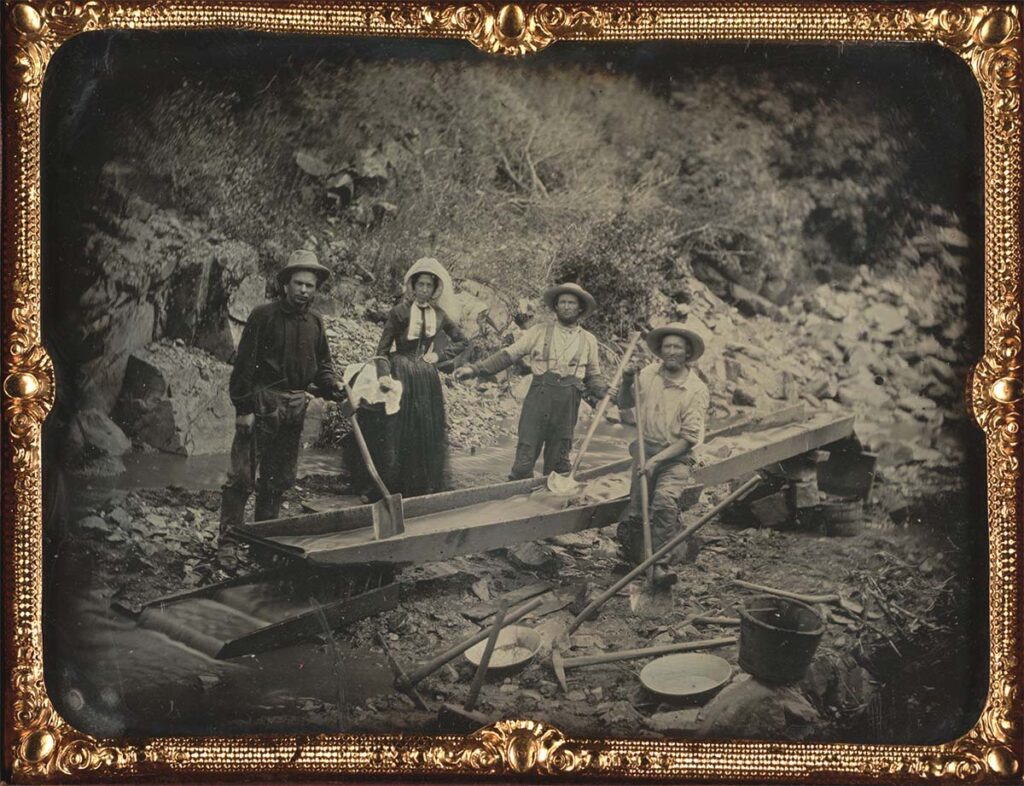
The new development was the Long Tom, an elongated cradle in which transverse cleats arrested these small gold particles. Soon, however, the Long Tom was superseded by sluices of various types.
Booming or gouging was the next innovation in mining technique. This consisted of merely letting water do the work of clearing away the sediment. A dam was built, and the water diverted through the area which was being mined; the water carried the lighter elements downstream, leaving the gold-bearing ore easily accessible to be worked by one of the other methods of placer mining.
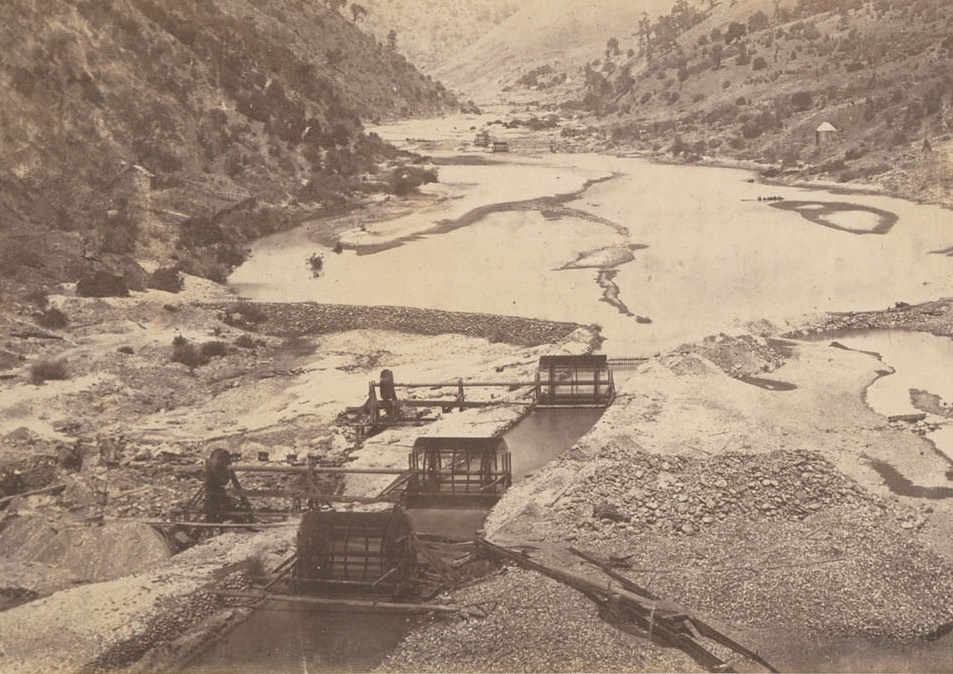
The success of this procedure soon brought about the introduction of hydraulic mining—the use of water under pressure. It is claimed that water was used in this manner at Yankee Jim’s in 1852. Perhaps more definite is the assertion that in the same year Anthony Chabot used the hydraulic method without a nozzle at Buckeye Hill, near Nevada City. Hydraulic mining seems to have been a California innovation, and was first employed, complete with the nozzle which is generally associated with this type of mining, in 1853.
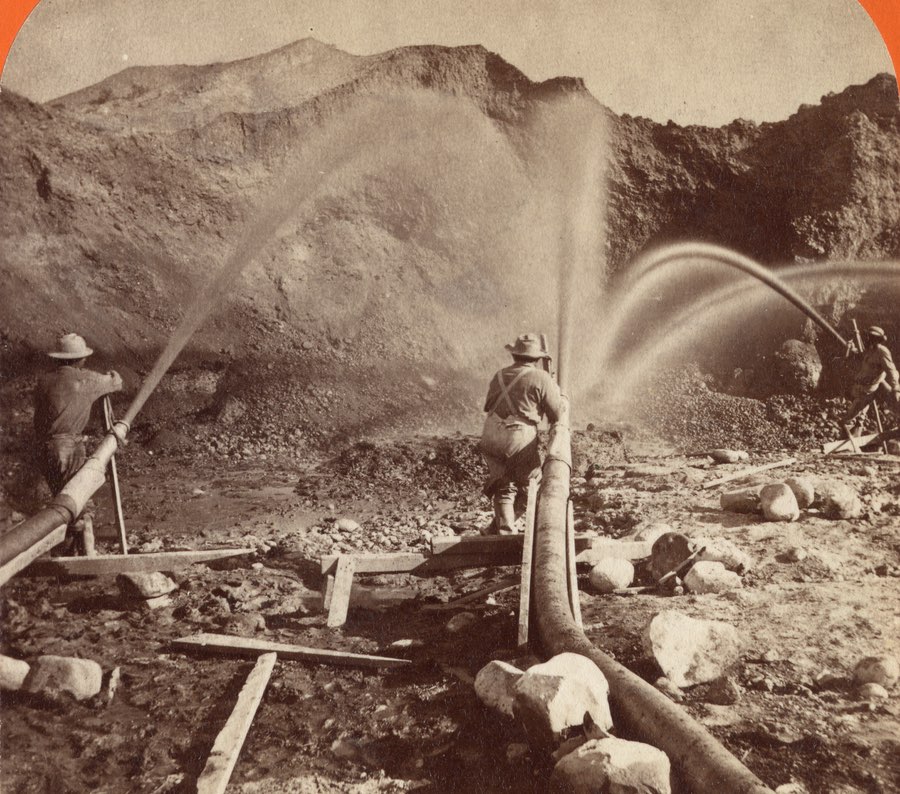
The idea of dredging gold was common, but early attempts resulted in failure. Characteristic is the example of an operation on the Yuba River in 1853 in which the dredge sank almost immediately. Despite many subsequent dredging endeavors, it was not until 1898 that the first real success was achieved. This was accomplished with a bucket elevator dredge used on the Feather River near Oroville.
Letters From the Forty-Niners
While many perceive the lives of the Gold Rush pioneers as romantic and adventurous, the reality for most was one of back-breaking labor, hunger, exposure to the elements, and disease. Many accounts of the experiences of these pioneers were captured in letters sent back home, or in journals. The following excerpts give a first-hand account of what life was like for these men.
William Swain’s Letter Home
William Swain traveled to the California gold fields from Youngstown, New York in late 1848. In a letter home written in December of that year he describes the conditions in California and some of the hardships he has endured. The following are selected passages from that letter:
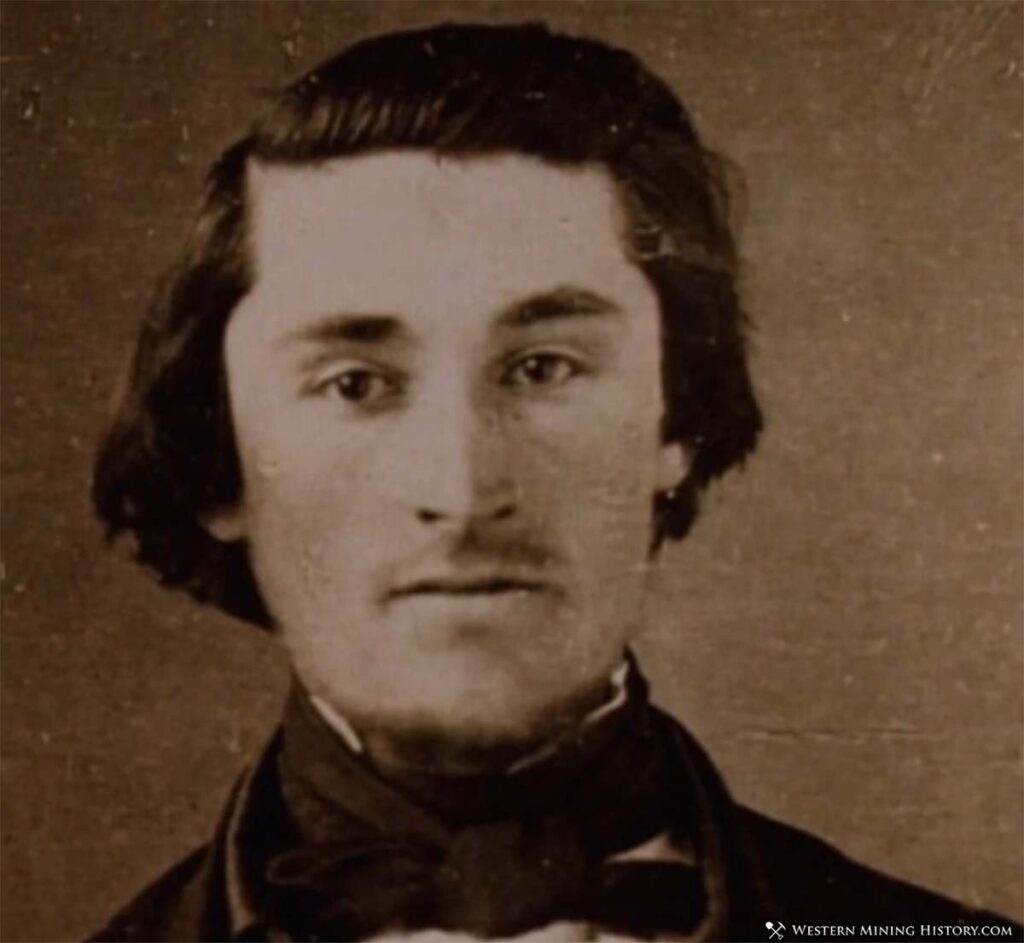
“Gold is found in the most rocky and rough places, and the streams and bars that are rich are formed of huge rocks and stones. In such places, you will see, it requires robust labor and hard tugging and lifting to separate the gold from the rock. But this is nothing to the risk of life run in traveling to this country. Therefore, if I was at home and knew all the circumstances, I think I should stay at home; but having passed those dangers in safety, I thank God that I am here in so favorable circumstances.”
“George, I tell you this mining among the mountains is a dog’s life. A man has to make a jackass of himself packing loads over mountains that God never designed man to climb, a barbarian by foregoing all the comforts of civilized life, and a heathen by depriving himself of all communication with men away from his immediate circle.”
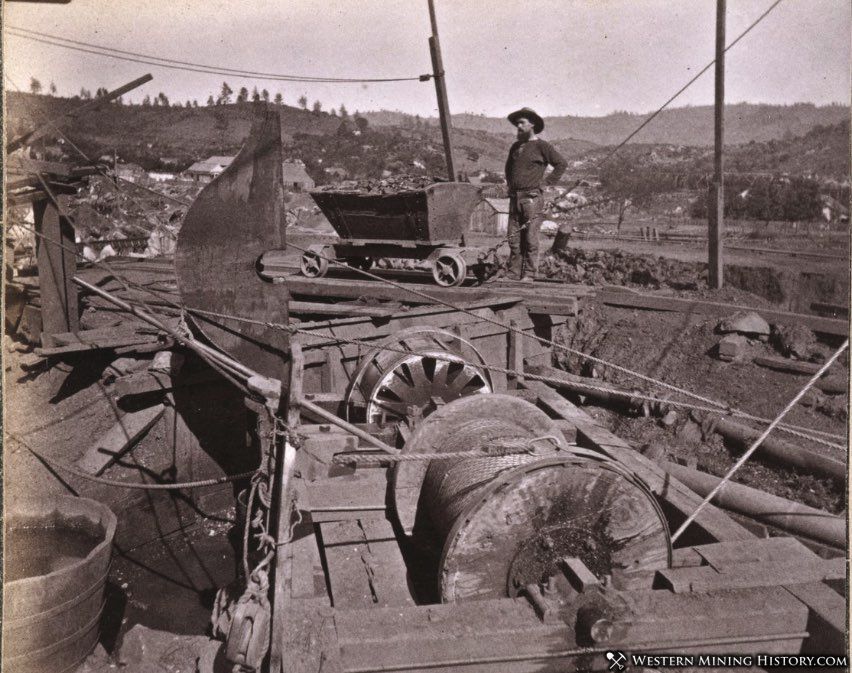
“There was some talk between us of your coming to this country. For God’s sake think not of it. Stay at home. Tell all whom you know that are thinking of coming that they have to sacrifice everything and face danger in all its forms, for George, thousands have laid and will lay their bones along the routes to and in this country. Tell all that “death is in the pot” if they attempt to cross the plains and hellish mountains.”
“Say to Mr. Burge that this climate in the mines requires a constitution like iron. Often for weeks during the rainy season it is damp, cold, and sunless, and the labor of getting gold is of the most laborious kind. Exposure causes sickness to a great extent, for in most of the mines tents are all the habitation miners have. But with care I think health can be preserved.”
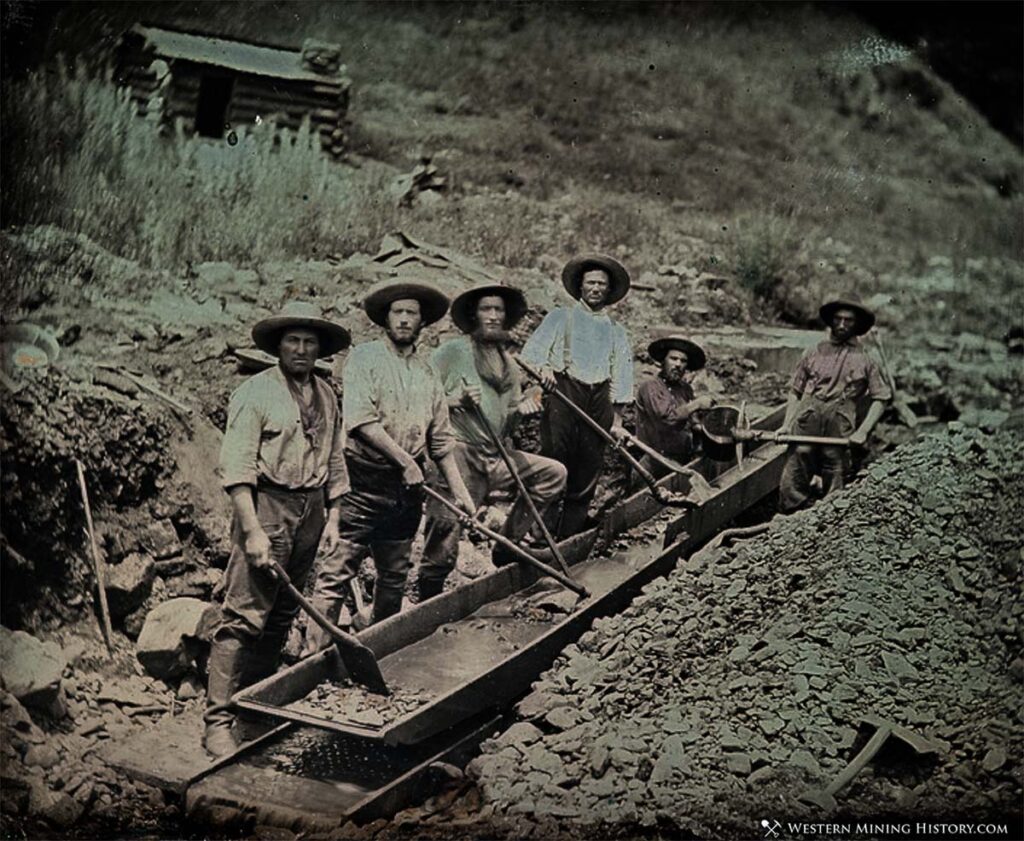
Hardships of the Gold Rush
An unattributed letter from November, 1849 that was published in a New York newspaper describes the difficult conditions found in San Francisco:
“Of course there is a great deal of suffering; a large number die every day, whose deaths are not published; several bodies are found every morning on the beach, and under carts where they have crawled for shelter. The principal disease is Dysentery, although dissipation and exposure kills a great many. Indeed, I never have seen so much dissipation in my life as prevails here. Every one drinks, and gambling is going on in almost every house, from eight in the morning until two and three at night, Sundays not excepted, and thousands change hands every day.”
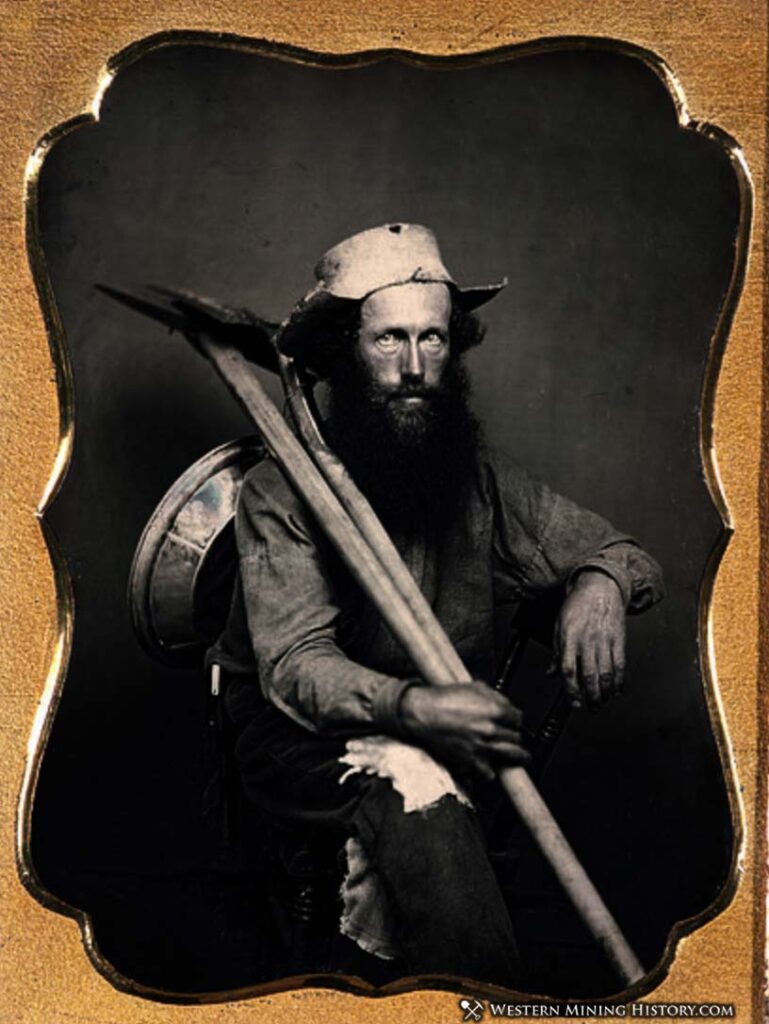
“It is astonishing to what menial offices man have to resort here, who have left good and even lucrative situations at home. I will give you a few cases that have come under my observation. A gentleman who left a Professorship in Yale College, has been attending bar in a grog shop, and driving an ox team; another, a clerk who had a situation in Wall street, with $2,000 a year, is now driving a cart through the mud; at any time you can see dozens who were well off, digging ditches in the streets for $7 a day; a great many get discouraged, gamble and dissipate, until all their money is gone, and their health ruined, and then they either commit suicide, or crawl away under some budding and are found dead.”
“I must own that I have been grievously disappointed with regard to this place. Do not advise any person to come here unless they can bring plenty of capital, and if they can do that they are much better off where they are.”
Impact of the California Gold Rush
The economic consequences and significance of the discovery of gold are equally great but harder to determine. Increased production in the United States, followed by increased foreign production resulting from the California gold rush, caused an increase of money in circulation.
Reports on how much gold was recovered during the Gold Rush vary widely, but it is safe to assume it was many billions of dollars worth at modern prices. In spite of the heavy increase of circulating gold, the much-feared serious inflation, which was predicted by economists, failed to materialize.
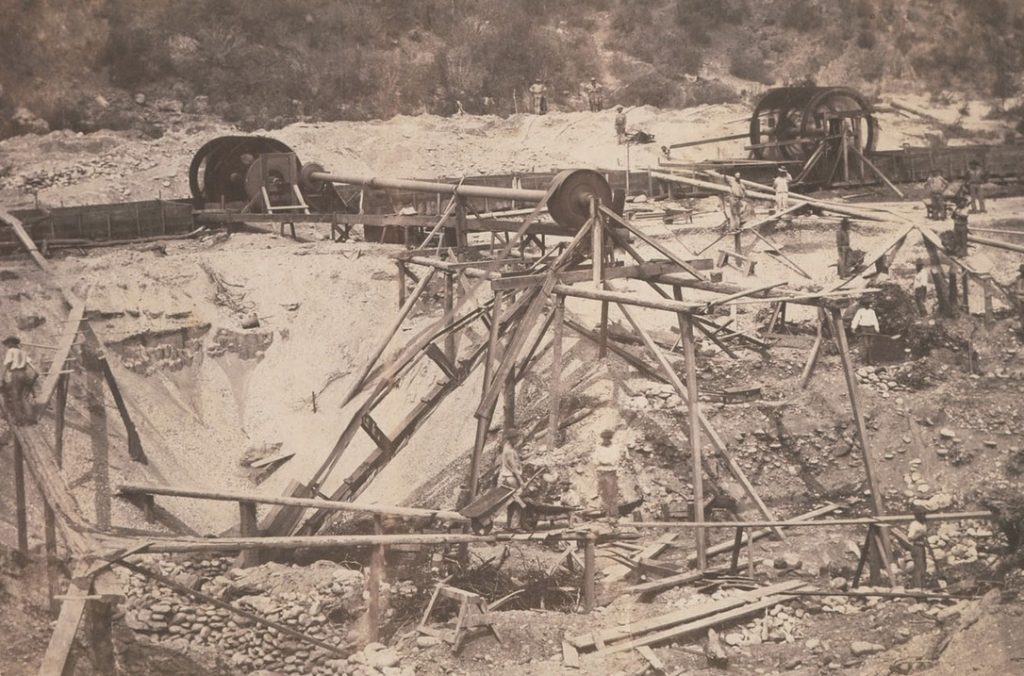
Other important results of the gold rush were that it opened the era of modern mining; hastened the colonization of the West and the suppression and partial elimination of the Native American population; accelerated the expansion of the agricultural frontier by the need for a food supply in the gold area; and hastened the linking of the East and West.
Related: Where to Find Gold in California